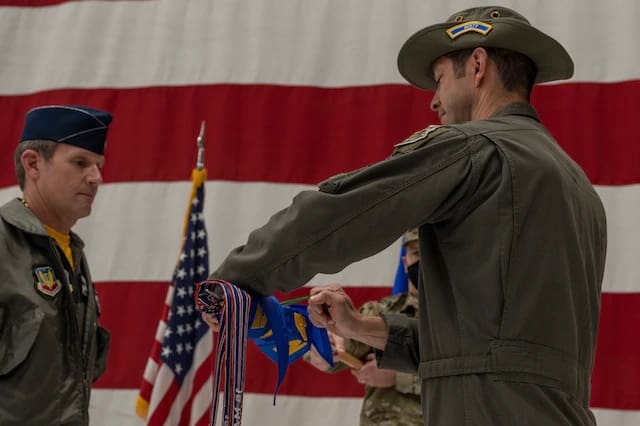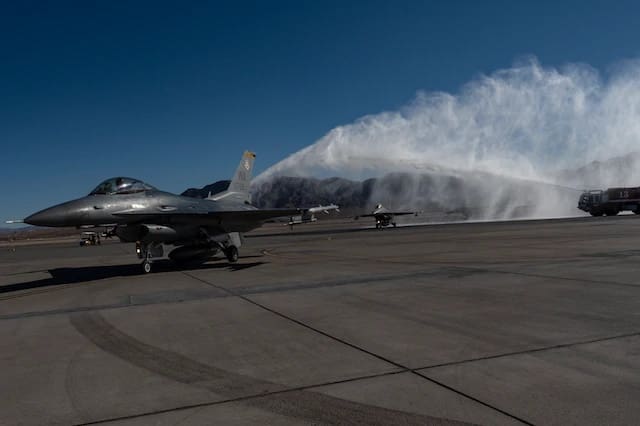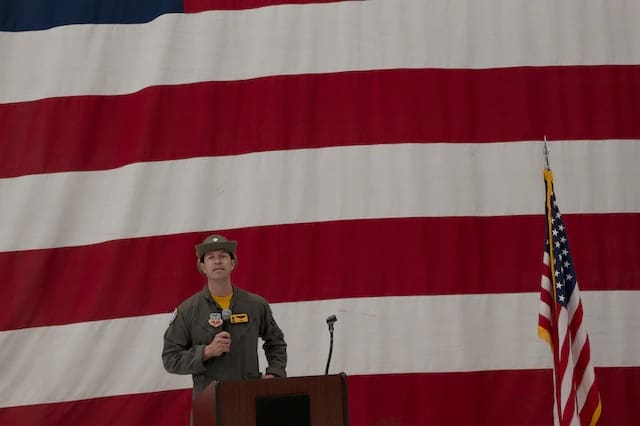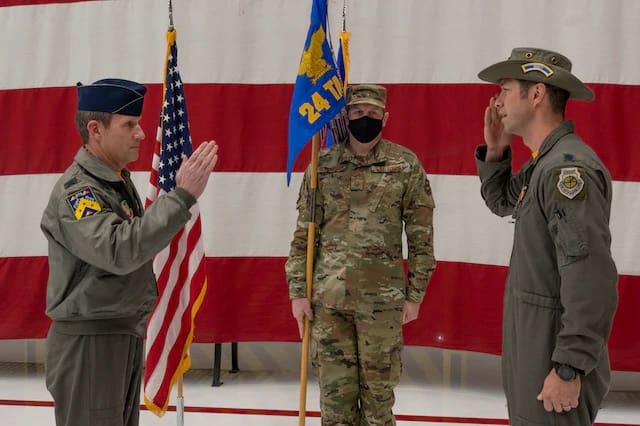NELLIS AIR FORCE BASE, Nev. —
The 24th Tactical Air Support Squadron was inactivated during a ceremony at Nellis Air Force Base, Nevada, Dec. 23, 2020.
The inactivation is part of an overall Air Force strategy to reactivate the 65th Aggressor Squadron.

“Our era of great power competition is highlighting the need to integrate across domains – air, land, sea, space, cyberspace and information,” said Lt. Col. Jesse Breau, 24th TASS commander. The force that is able to effectively and consistently accomplish that integration will win against peer adversaries. Forces who are unable or who choose not to integrate in training will become obsolete.”
The Air Force is repurposing the F-16s assigned to the close air support-focused 24th TASS and moving them to an aggressor role as part of the 65th AGRS to enhance air-to-air training and provide adversary aircraft that will better replicate peer adversary military forces.
The 24th TASS was activated at Nellis in March 2018. Its primary mission was to train forward air controllers (Airborne) and joint terminal attack controllers. The squadron’s pilots flew F-16 Fighting Falcons, more commonly known as the “Viper.”

As part of the inactivation ceremony, a 24th TASS Viper conducted a fini flight, celebrating the unit’s rich history.
During the Vietnam era, the 24th TASS’ operators wore non-standard headgear known as Saigon Cowboy hats that link them to the rich heritage of USAF forward air controllers.
While activated at Nellis, the unit’s tactical air control party members hosted JTACs and meshed them with pilots from the combat air force. Pilots who completed a demanding seven-week course were then qualified to control CAS airstrikes from the cockpit of their fighter jets.
The 24th TASS’s mission was unique in that it was the only centralized FAC (A) training course in the United States Department of Defense. The former students and instructors from the 24th TASS will carry on the unit’s legacy of air-ground integration and CAS expertise as they move on to other assignments throughout the CAF.

“There are very few fighter pilots in the U.S. Air Force that know Army or Marine Corps doctrine and tactics. So in that sense, I think one of the key outputs of the forward air controller training course is an officer who can integrate joint fires,” said Breau. “Graduates of our course are focused on close air support and integrating airpower with surface forces’ maneuver and fires. They graduate as close air support subject matter experts, and bring that knowledge back to their combat units.”
The 24th TASS’s training leveraged the Nevada Test and Training Range and the wide range of aircraft types stationed at Nellis to provide premier CAS training. The course immersed fighter pilots into the TACP members’ mission through planning, briefing, executing the mission on range and debriefing with the JTACs.

“To integrate with the ground scheme of maneuver, our philosophy that’s written into joint fires doctrine is that a forward air controller should always be an extension of the tactical air control party,” said Maj. Andrew Bolint, 24th TASS director of operations. “So the JTACs on the ground with the special operations teams just need us to support their objectives and extend their capabilities, whether that’s firepower, sensors or communication.
“What I took away as a forward air controller pilot that completed and eventually managed the course is an understanding of the ground scheme of maneuver and the ground force commander’s objectives for each mission,” he added. “This taught me to better predict where and how to allocate weapons and sensors that would best support friendly forces on the ground.”
The result was a high level of trust and rapport between the JTACs and fighter pilots, along with an in-depth understanding of the purpose and role of all of the air and ground players involved in the training mission scenarios.
“The in-person planning and debriefs isn’t common for JTACs and pilots, however it is an invaluable way to increase the lethality of the CAS team,” said Master Sgt. Andrew MacDonald, 24th TASS TACP flight chief and JTAC instructor.
Although there will no longer be a centralized USAF F-16 FAC(A) training course, the future of air-ground integration is in good hands, according to Breau. Several Nellis Combat Training Squadrons are dedicated to joint integration exercises, and the USAF Weapons School continues to produce expert weapons officers.
“What will always be useful in large-scale combat operations will be the ability to mesh across domains, and the forward air controllers and JTACs that we’ve helped to train have the expertise to do that,” said Breau.
Additionally, the Congressional decision to maintain the A-10 platform ensures that Close Air Support focus and institutional knowledge remains.
“I think the 24th TASS has done an exceptional job of training for what a major conflict will look like, in terms of threats,” said 1st. Lt. Benjamin Harris, 24th TASS intelligence officer in charge. “Some of our training audience are unfamiliar with advanced integrated air defense systems and ground force tactics that we expect to face in a fight with peer adversaries.
“Since we plan, brief, execute and debrief every tactical air support mission as an air-ground team, our student pilots and operators completed the course with the ability to cover each other’s blind spots and leverage each other’s strengths,” he added.
The decision to inactivate the squadron was finalized in May 2020 by Gen. Mike Holmes, former commander of Air Combat Command.
Story by 2nd Lt Nicolle E. Mathison, 57th Wing Public Affairs
Photos by TSgt Alexandre Montes


I’m not in a position to judge how much value the “Forward Air Controller (Airborne)”, in a cockpit, brings to the fight (though I suspect it’s a lot, both directly and indirectly). And I recognize the importance of prepping for “near-peer”. But the way I read the spin of this article is that, without a centralized training program, this is just a hard-earned capability which will be allowed to evaporate away, over probably 12-24 months, as whatever required currency dates, skill levels, and personnel reassignments take their toll. I hope this is not the beginning of another era of USAF CAS as an afterthought.